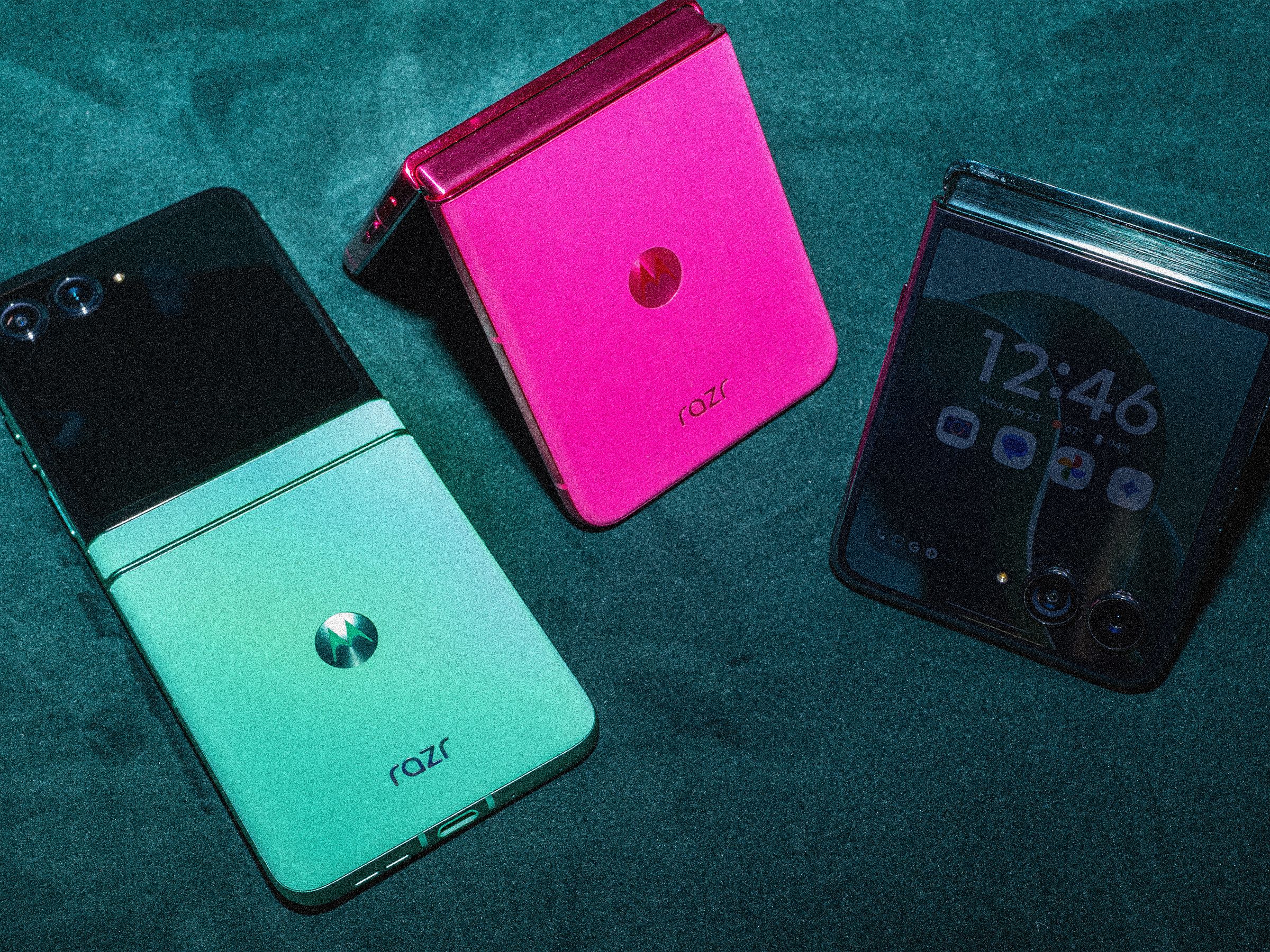Motorola unwrapped new Razr folding smartphones today—the Razr, Razr+, and Razr Ultra—the latter a pricier model that expands the family. But at the company’s closed-door launch event on Wednesday in New York City, much of the spotlight was on Moto AI, artificial intelligence features powered by in-house and third-party large language models, like Meta’s Llama.
Google’s Gemini is naturally available on the Razr phones, but for the first time, the AI search engine Perplexity AI will be preinstalled on the devices. The CEO of Perplexity, Aravind Srinivas, took the stage to talk about the optimizations made to take advantage of the Razr’s unique design. Motorola even says Microsoft’s Copilot will also be available in the coming months. That’s a whole lot of AI for such small phones.
The 2025 Razr lineup starts at $700 for the base Razr, $1,000 for the Razr+, and $1,300 for the Razr Ultra; the midrange Razr+ is almost the same device as the Razr+ from 2024, with a few enhancements to durability. It wasn’t all phones, either. Motorola showed off new open-ear earbuds called Moto Buds Loop, complete with a Sound by Bose collab and Swarovski crystals embedded into the earbuds. And the Moto Watch Fit is a basic fitness watch for Android phones. Here’s everything you need to know.
The 2025 Razr Family
The Razr+ on the left, Razr Ultra in the middle, and Razr on the right.
Photograph: Julian Chokkattu
The core change throughout the Razr 2025 lineup is the build quality. Motorola says a new titanium-reinforced hinge plate makes all the Razr models four times stronger than the previous stainless steel; it can withstand 35 percent more folds than before. The glass is thinner, which Motorola says allows for less of a crease at the fold, and the IP48 dust- and water-resistance is a small step up from most folding phones that aren’t rated for any dust protection.
The Razr Ultra specifically employs Corning’s Gorilla Glass Ceramic, not unlike Apple’s Ceramic Shield on its iPhones, for supposedly 10 times better drop performance. (The Razr+ and Razr use Gorilla Glass Victus.)
Texture and color are other ways Motorola is trying to differentiate its smartphones. The company says in 2024, 65 percent of the phones it sold were not dark or neutral tones—colors that have long dominated the smartphone market. That’s why the new Razrs have a rich, colorful palette. Textures also play an important role, hence the Razr Ultra comes in four finishes: Mountain Trail, which uses FSC-certified wood; Scarab, which is the first-ever use of Italian-made Alcantara on a smartphone; Cabaret, for a satin-inspired finish; and Rio Red, for a leather-inspired look.
Motorola also claims 25 percent of its Razr customers come from iOS, an unusually high figure in a category where iPhone owners tend to stick with Apple’s hardware. More incentive for Apple to prioritize a folding iPhone.
The Razr+ and Razr Ultra retain that larger 4-inch external screen, over the Razr. Motorola says it’s more customizable, with the ability to add dedicated panels for your friend’s contact info, music streaming panels, and even more widgets for quick, glanceable access without constantly opening the phone. When you flip it open, the Razr Ultra now boasts the largest 7-inch screen of the lot, achieved by narrowing the bezels around the display.
The Razr Ultra’s 4-inch front screen.
Photograph: Julian Chokkattu
On the camera front, the main change is with the Razr Ultra. The second camera is now an ultrawide, while the telephoto stays on the Razr+ model. This was a slightly controversial move last year, when the Razr+ cut the ultrawide in favor of a 2X optical zoom. Having an ultrawide on a flip makes it easy to fit more people in the frame in group shots. The Ultra is also the only model of the lot that can capture videos in Dolby Vision, for more accurate colors.
All three devices can take advantage of a new photo feature called Signature Style, which lets you adjust the colors and tones of a photo, which can then be applied to all your images for a personalized aesthetic. But the Razr Ultra has some exclusive features. Group Shot is like Google’s Best Take on Pixel phones, merging images to avoid a group photo where one person is blinking. Action Shot changes the shutter speed to make sure motion is tack-sharp, and Air Gesture lets you start video recording hands-free with a palm gesture, and stop recording with a fist.
The Ultra has the biggest battery, and it charges the fastest—wired and wirelessly—supporting 68-watt wired and 30-watt wireless charging. It’s also the only Razr with a dedicated “AI key,” a button on the left edge of the phone that triggers Moto AI.
Moto AI
The Alcantara Razr Ultra sits at the top.
Photograph: Julian Chokkattu
Motorola announced Moto AI last year and opened it up for beta, and the company says it has been refining the features based on user feedback. While you’re able to use Google’s Gemini assistant on these phones like other Android devices, you can now access Perplexity AI through the preinstalled app or Moto AI if you ask to “talk to Perplexity.”
Moto AI’s core features are Catch Me Up, Remember This, and Pay Attention. Catch Me Up summarizes notifications, prioritizing urgent messages, if you’re coming back to your Razr after some time and have a pile of notifications to sift through. Remember This lets you ask Moto AI to remember anything, even ask it to save screenshots, and you can ask it to recall that information later on. Pay Attention starts an audio recording, where the Razr will auto-transcribe a conversation and provide a summary at the end.
A few new tricks are here that weren’t announced before, like Next Move. This predicts what you might want to do based on what’s on the screen. Naturally, Motorola also has some AI generation services—Image Studio lets you create AI-generated art, and Playlist Studio comes up with a fresh playlist based on a prompt, though it seems to only work with Amazon Music right now.
If you put the Razr Ultra in tent mode, you’ll enable a hands-free Moto AI mode, which lets you have a conversation with Motorola’s assistant without manually activating it.
Moto Things
The Moto Watch Fit.
Photograph: Julian Chokkattu
The Moto Buds Loop.
Photograph: Julian Chokkattu
Rounding out the announcements are “Moto Things,” Motorola’s umbrella term for accessories. They include open-ear earbuds, the Moto Buds Loop, and a new smartwatch, the Moto Watch Fit.
Open-ear earbuds are all the rage, and Motorola is elevating the look and sound with two collaboration partners: Bose and Swarovski. Yes, the earbuds have Sound by Bose for souped-up audio quality, and there’s a version of the Buds Loop with Swarovski crystals. They have all the standard features you’d expect in earbuds today, from spatial sound support and a water-repellent design to 37 hours of battery life with the case alone (8 hours for the buds). No word on the price, though they arrive this summer.
The Watch Fit is not a Wear OS smartwatch, so you won’t be able to use your favorite apps on this fitness watch. It works with any Android phone, and the Apple Watch-inspired 1.9-inch OLED screen will let you check notifications, control music playback, and track workouts. It can track your heart rate, sleep, and blood oxygen, plus it sports built-in GPS. It has an IP68 water-resistance and a 5 ATM rating, and 16 days of battery life. Motorola did not share pricing, but this wearable will arrive sooner in the “coming weeks.”
The Razr, Razr+, and Razr Ultra will be available for preorder starting May 7, and they officially go on sale May 15.




